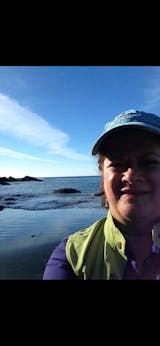Want to go mudlarking on the Thames? Not so fast!

While you may visit the foreshore, if you do not have a permit you may not search the tidal Thames foreshore from Richmond Lock near Teddington to the Thames Barrier — in any way for any reason. No searching/digging is allowed for anyone on the foreshore of the River Thames east of the Thames Barrier. Unlike many other shorelines, the Port of London Authority (PLA) and the Crown Estate are the largest landowners of Thames foreshore and jointly issue a permit, which is administered by the PLA, for searching, metal detecting, beachcombing, scraping, and digging.

Areas along the Thames where a permit is required.
In order to do anything that disturbs the surface of the foreshore you must have a permit from the PLA. However, to protect the unique historical integrity of the Thames foreshore, the ability to request new Foreshore Permits is now limited. Learn about applying for a permit ›
The move comes as permits have surged from just 200 five years ago to over 5,000 in 2024. Reports of mudlarks selling their finds (which isn't permitted) or keeping them and not reporting them (also not allowed) have also spurred the change. Basically, there are just too many active permits today and the objects found on the foreshore are in danger of disappearing forever.

The foreshore remains open at this time, so you can still visit the area, you just can’t pick anything up. Even with a permit, digging, scraping, and metal detecting are restricted or prohibited in some areas. See the map on the PLA website. Magnet fishing in the tidal Thames is not allowed.

Safety considerations
- The foreshore is a tidal river with a cold, fast current so always check tide tables on the PLA website before visiting.
- Dress for the rough surface of rocks, metal, and other debris. Wear thick-soled boots, rubber gloves, and plan on your clothing getting muddy.
- The stairs and rocks can be very slippery and there's always a chance you'll come in contact with hazards such as raw sewage, broken glass, needles, sharp metal, and more.
- If you have flu-like symptoms after coming in contact with the water, seek medical attention immediately to check for Weil's Disease.

Reporting your finds
- Holders of Foreshore Permits may not sell items taken from the foreshore for personal gain.
- You must report any and all objects you find which could be of archaeological interest to the British Museum’s Portable Antiquities Scheme (PAS) Finds Liaison Officer at the Museum of London swyatt@museumoflondon.org.uk. The PAS records all archaeological finds made by the public in England and Wales. These finds have the potential to tell us much about the past, such as how and where people lived and about the types of objects they made and used. Learn more about advice about reporting your finds to the Portable Antiquities Scheme.
- Under the Treasure Act 1996 there is a legal obligation to report all finds of treasure. Learn what constitutes treasure on page 5 of the Portable Antiquities Scheme – Advice for Finders guide.
- An export license is required if you intend to leave the UK with any archaeological objects of more than 50 years of age. The type of license required will depend on where the object was found and, in some cases, the value of the object.

Visiting the foreshore without a permit
If you don't have a permit, you can still have the mudlarking experience of finding, photographing, and identifying artifacts found on the surface of the foreshore with the Thames Explorer Trust or the Thames Discovery Programme. An expert guide will help you search for traces of history and take photographs of your finds. If you would like to visit the foreshore with an organized group, please check the Thames Explorer Trust or the Thames Discovery Programme for their lists of guided tours.
If you want to organize your own group visit to the foreshore that doesn't involve any disturbance of the foreshore, you must apply for PLA permission at estates3@pla.co.uk.
Learn more about mudlarking
Learn more about the experiences of mudlarks, who search the shores of rivers, bays, and seas for historical finds and other objects. Articles ›
2 comments
Well that just took all the fun out of the thought and going there to do that! Doesn’t the Royal Family and England have enough of their own stuff to also want to take something so fun away from common folks! What are they worried someone is going to find something really valuable then they should be able to keep it! This planet and what’s on it was created by man and if it was thrown out then whomever wants to collect it and clean it should keep it too!
Marvellous history of the Thames mudlarking also an historical thing to do .










